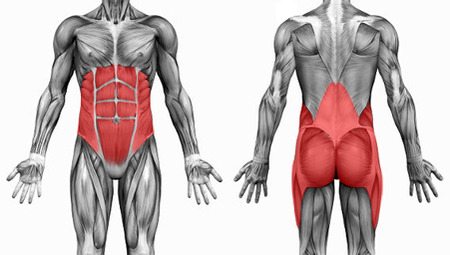Terms
- Inspiration: breathing in (a.k.a., inhalation; not motivation) Always an active process caused by muscular contraction, mainly of the diaphragm intercostal muscles. (http://faculty.stcc.edu/AandP/)
- Expiration: breathing out (a.k.a., exhalation; not dying!) Typically a passive processmainly caused by elastic recoil of the diaphragm relaxation of the intercostal muscles. (http://faculty.stcc.edu/AandP/)
- Thoracic diaphragm: separates your lung region from your abdomen region
- Pelvic diapragm / Pelvic floor: separates the abdomen from the genital region
Points-of-Performance
- Prior to movements – pressing, lifting, jumping, pulling, etc – inhale (inspiration) by filling your chest and stomach SIMULTANEOUSLY while noticing a deep contraction inside the chest and deep in your abdomen. You should feel deep pressure up and down within your core…a “pressing” feeling from within.
- If you experience a “full” chest feeling, but your stomach “emptying” (gets real shallow), then you are NOT stabilizing the core.
- Imagine a balloon filling up with pressure experienced in a 360-degree manner. This is what we mean when we say “belly tight”.
Clarification
Achieving this “fullness” feeling can still be maintained while breathing. Achieving this type of contraction is similar to the “bracing” motion we experience when anticipating someone or thing about to hit you in the stomach, i.e getting gut punched.
Try this; stand upright and pretend someone is going to “gut punch” you hard. You instinctively fill your chest and abdomen quickly to brace for the impact thereby stabilizing the “core” region and mitigating the results of the impact. Again, if you feel your chest get real big (inflated) but your belly “sucks” deeply in, then your are not properly stabilizing the core area. However, if inspiration is done correctly, outward pressure to all areas of your torso will be achieved – pressure against your lower chest and abdomen, specifically the rectus abdominis, quadratus lumborum, transverse abdominus, and psoas.
Specific Notes
“The psoas and quadratus lumborum are interrelated muscles, in that contraction of one evokes contraction of the other through neurophysiological connections. This works well because both muscles wrap around and stabilize the lumbar spine”. (http://www.bandhayoga.com/keys_access2.html)
“The diaphragm can perform the breathing task at a lowered position ensuring that the stabilizing pressure is maintained throughout the breathing cycles. There is a close relationship between the diaphragm and transversus abdominis which contributes to the respiratory and postural control.” (http://www.mikereinold.com/2012/03/core-stability-from-the-inside-out.html)
“These two studies pointed out that the activity of the diaphragm during stabilization varies greatly amongst individuals, which supports Kolar’s clinical evidence that individuals with limited capability to contract the diaphragm for stabilization have a higher risk of developing back-pain. The simultaneous activation of the diaphragm’s dual functions is the key to proper core stabilization.” (http://www.mikereinold.com/2012/03/core-stability-from-the-inside-out.html)
Lastly, ref this video by Hans Lindgren, Doctor of Chiropractic and DNS Practitioner in Brisbane, Australia.
Train hard, but train correctly.
“Correct technique is the most efficient display of strength.” Ripp
[jetpack_subscription_form]

